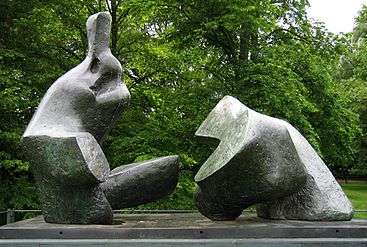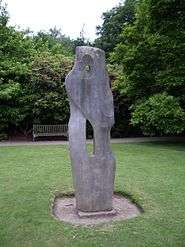Kenwood House
| Kenwood House | |
|---|---|
 Front (north) facade, 2005 | |
| General information | |
| Type | Stately home |
| Architectural style | Georgian and Neoclassical |
| Location |
Hampstead Heath |
 Location of Kenwood House in London Borough of Camden | |
| Coordinates | 51°34′17″N 0°10′03″W / 51.5713°N 0.1676°WCoordinates: 51°34′17″N 0°10′03″W / 51.5713°N 0.1676°W |
| Built | c. 1616 |
Listed Building – Grade I | |
| Official name: Kenwood House (Iveagh Bequest) | |
| Designated | 10 June 1954 |
| Reference no. | 1379242[1] |
Listed Building – Grade II* | |
| Official name: Service wing and outbuildings to Kenwood House | |
| Reference no. | 1379244[2] |
Listed Building – Grade II* | |
| Official name: Sham bridge to south of Kenwood House | |
| Reference no. | 1379245[3] |
| Designated | 1 October 1987 |
| Reference no. | 1000142[4] |
| Design and construction | |
| Architect | Robert Adam |
Kenwood House (also known as the Iveagh Bequest) is a former stately home, in Hampstead, London, on the northern boundary of Hampstead Heath. It served as a seat for the aristocratic Murray and Guinness families and had various tenants.
History
The original house dates from the early 17th century when it was known as Caen Wood House.[5] The orangery was added in about 1700. In 1754 it was bought by William Murray, 1st Earl of Mansfield. He commissioned Robert Adam to remodel it from 1764–1779. Adam added the library (one of his most famous interiors) to balance the orangery, and added the Ionic portico at the entrance. In 1793-6 George Saunders added two wings on the north side, and the offices and kitchen buildings and brewery (now the restaurant) to the side.
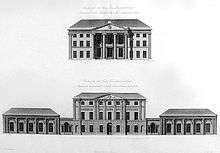

The 2nd Earl and Countess of Mansfield added a dairy to supply Kenwood House with milk and cheese.[6] After two years of negotiations, the 6th Earl of Mansfield leased the house to the exiled Grand Duke Michael Mikhailovich of Russia and his wife Countess Sophie of Merenberg in 1910.[7]
Lord Iveagh, a rich Anglo-Irish businessman and philanthropist (of the Guinness family), bought the house from the Mansfield family in 1925 and left it to the nation upon his death in 1927; it was opened to the public in 1928. The furnishings had already been sold by then, but some furniture has since been bought back. The paintings are from Iveagh's collection. Part of the grounds were bought by the Kenwood Preservation Council in 1922, after there had been threats that it would be sold for building. In 2017, 143,490 people visited the house.[8]
Estate
The estate has a designed landscape with gardens near the house, probably originally designed by Humphry Repton, contrasting with some surrounding woodland, and the naturalistic Hampstead Heath to the south. There is also a new garden by Arabella Lennox-Boyd.
The estate is Grade II* listed on the Register of Historic Parks and Gardens.[9] One third of the estate is a Site of Special Scientific Interest, particularly the ancient woodlands. These are home to many birds and insects and the largest Pipistrelle bat roost in London.
There are sculptures by Barbara Hepworth, Henry Moore and Eugène Dodeigne in the gardens near the house.
|
Music concerts, originally classical but in more recent years predominantly pop concerts, were held by the lake on Saturday evenings every summer from 1951 until 2006, attracting thousands of people to picnic and enjoy the music, scenery and spectacular fireworks. In February 2007, English Heritage decided to abandon these concerts owing to restrictions placed on them after protests from some local residents. On 19 March 2008, it was announced that the concerts would return to a new location on the Pasture Ground within the Kenwood Estate, with the number of concerts limited to eight per season.[10]
The house was closed for major renovations from 2012 until late 2013.[11]
In popular culture
The house was the subject of a Margaret Calkin James poster in the 1930s, seen by many commuters on the London Underground.
The 1999 British feature film Notting Hill had a scene filmed here.
The 1995 British feature film Sense and Sensibility had scenes filmed here.
Many scenes in the 2013 film Belle, in which William Murray figures as a character, are set in the house or its grounds, although filmed elsewhere.[12]
A scene from the 2016 novel Swing Time by Zadie Smith is set on the grounds of the estate.
Paintings and other collections
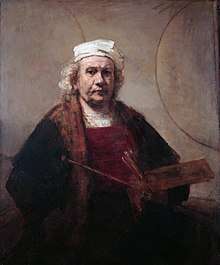
Paintings of note include
- The Guitar Player by Johannes Vermeer
- Self Portrait with Two Circles, a late Rembrandt self-portrait
- Portrait of Pieter van den Broecke, by Frans Hals
- Thomas Gainsborough, 'Portrait of Countess Howe' (wife of Richard Howe, 1st Earl Howe)
- Edwin Henry Landseer, 'Hunting in the Olden Times'
Other painters include
- Joshua Reynolds, 'The Hon'ble Mrs Tollemache as Miranda'
- Angelica Kauffman
- John Crome
- Claude de Jongh
- George Morland
- Anthony van Dyck
- William Larkin
- J. M. W. Turner
- Arthur Boyd Houghton
- François Boucher
- Thomas Lawrence, 'Miss Murray'
- Henry Raeburn
- George Romney
- Jan Baptist Weenix
- Joseph Wright
Most of the works were acquired by Iveagh in the 1880s–1890s and are mainly Old Master portraits, landscapes and 17th century Dutch and Flemish works and British artists. Others were not part of the Iveagh Bequest but were added to the collection after his death because of a connection with Kenwood House.[14]
There is also a collection of shoe buckles, jewellery and portrait miniatures.
In 2012, an exhibition of works from the art collection, Rembrandt, Van Dyck, Gainsborough: The Treasures of Kenwood House, London began a tour of museums in the United States while Kenwood House was undergoing renovations; many of the works had never been outside Britain. The exhibit opened 6 June 2013 in Little Rock, Arkansas at the Arkansas Arts Center.[15][14]
Gallery
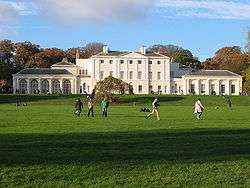 Rear (south) facade of Kenwood House
Rear (south) facade of Kenwood House Detail of the rear (south) facade of Kenwood House
Detail of the rear (south) facade of Kenwood House The library
The library Interior shot
Interior shot The library of Kenwood House
The library of Kenwood House
Notes
- ↑ Historic England. "Details from listed building database (1379242)". National Heritage List for England. Retrieved 28 December 2016.
- ↑ Historic England. "Details from listed building database (1379244)". National Heritage List for England. Retrieved 28 December 2016.
- ↑ Historic England. "Details from listed building database (1379245)". National Heritage List for England. Retrieved 28 December 2016.
- ↑ Historic England. "Details from listed building database (1000142)". Register of Historic Parks and Gardens. Retrieved 28 December 2016.
- ↑ FK staff (9 April 2014). "History of Kenwood House and the Friends of Kenwood".
- ↑ "More than £40,000 needed to restore 18th century Kenwood Dairy". Ham&High. 8 October 2012.
- ↑ Bryant, Julius (1990). The Iveagh Bequest: Kenwood. Oxford, UK: London Historic House Museums Trust. p. 68. ISBN 9781850742784.
- ↑ "ALVA - Association of Leading Visitor Attractions". www.alva.org.uk. Retrieved 14 May 2018.
- ↑ Historic England, "Kenwood (1000142)", National Heritage List for England, retrieved 7 June 2017
- ↑ "IMG and English Heritage announce stunning line up for Kenwood House Picnic Concerts". Retrieved 29 April 2008.
- ↑ "History of Kenwood". English Heritage. Retrieved 26 February 2014.
Following an extensive repair and conservation project begun in 2012, part-funded by the Heritage Lottery Fund, Kenwood reopened in late 2013. Work included repairing the Westmorland slate roof and redecorating the exterior and interior of the house, based on new paint research on the original Adam scheme, and a redisplay of the Iveagh Bequest paintings in the south front rooms.
- ↑ Internet Movie Database. "Belle Filming Locations". Retrieved 2014-07-01.
- ↑ Bryant, Julius (2003). Kenwood, Paintings in the Iveagh Bequest. New Haven, CT: Yale University Press. pp. 70–77. ISBN 978-0-300-10206-2.
- 1 2 "Masterpieces from London's Kenwood House tours the US, brings works by Rembrandt, Gainsborough". The Washington Post. Associated Press. 1 June 2012.
- ↑ Glentzer, Molly (8 June 2012). "British treasures leave home for the MFAH". Houston Chronicle.
References
- The Buildings of England London 4: North. Bridget Cherry and Nikolaus Pevsner. ISBN 0-300-09653-4.
- Kenwood: The Iveagh Bequest. Julius Bryant. (English Heritage publication).
External links
| Wikimedia Commons has media related to Kenwood House. |
- English Heritage website for the house
- 'The Iconic Art of Kenwood House' on Google Arts & Culture
- "The Friends of Kenwood (or The Friends of the Iveagh Bequest)". 21 May 2014.
